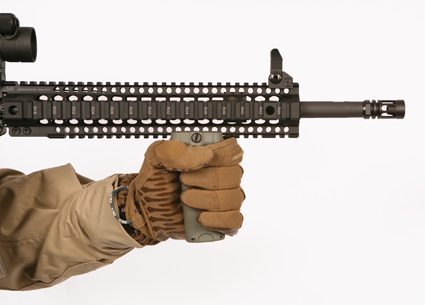Vertical Fore grips may be the most popular AR accessory purchased, but most people don’t know the history of them and why we use them on modern sporting rifles.

I just saw another picture posted on Facebook with a shooter holding the Vertical Fore Grip (VFG) on an AR like you would shooting a submachine gun.
How many of you have an AR-15 with a vertical fore grip? Are you gripping like you would milk a cow, thumb wrapped around? Or is your hand on BOTH the fore end AND grip, angled, providing rearward pressure, thumb up or over the fore end?
Vertical Fore Grips may be the most popular AR accessory purchased, but most people don’t know the history of them and why we use them on modern sporting rifles. Why have Vertical Fore Grips became popular? How can understanding their purpose help you with your shooting technique?
Forward grips saw increasing use on submachine guns between 1920 and 1950, the famous Thompson submachine gun (Tommy Gun) being the most popular example. A vertical fore grip allowed the submachine gun’s muzzle to be kept horizontal during automatic fire. It also kept the forward hand away from the hot barrel. Even after WWII, Vertical Fore Grips remained a feature almost entirely unique to submachine guns.
Vertical Fore Grips on modern sporting rifles began in the 1990’s when military special operations began using the SOPMOD kit. This was a collection of various M4 rifle accessories including lights and optics. One of the items in this kit was a vertical forward grip made by Knight’s Armament. It was included in the kit because the forward rails could become so crowded it was hard to hold the gun correctly when the other accessories were installed. AR-15 vertical fore grips soon became “The” accessory to have for anyone with a rail to mount one on. This has led to large scale misuse and poor shooting form, in my opinion.
I see many shooters using vertical fore grips the way they were designed to be used on full autos, but not on ARs. If it is used like that when there is no other place to put your support hand, such as when your forward rail is taken up by essential equipment or when there is insufficient fore end space to begin with, then I get it. But the closer our hand can be to the barrel, the more “instinctive” your shooting position, posture, and platform will be.
Close your eyes and point to a target. Open your eyes and you should find that you were pretty close. Close your eyes again and touch your finger to your nose. Nailed it! Proprioception is the word of the day. Proprioception is our ability to instinctively know where our limbs are in space (spatial awareness). Proprioception goes only as far as our body parts do, so the farther we get from our hands the more guesswork we have to do to point or hold something in the right spot.
You want to let your intuitive functions such as proprioception do as much work for you as possible to obtain maximum control over the muzzle of the rifle. This means gripping farther out on the fore end and closer to the barrel. This puts your support arm more in line with the barrel, which will help you point faster, more instinctively, and more accurately. Your hand is now closer to the bore line that allows you to exert a downward pressure on the front of the gun in order to counteract muzzle climb. Do not lock the elbow of your support arm. the support arm should help absorb recoil.
So if I am telling you to grab the fore end of the rifle, why have a Vertical Fore Grip if there is room to hold the fore end? A vertical fore grip can still be a great accessory by providing a stable spot on the fore end to index your support hand and to help seat the butt stock firmly in the shoulder by applying pressure to the rear. You can also help alleviate wrist strain by using an Angled Fore Grip (AFG).
Watch pictures and videos of top 3-Gun competitors and tell me what you see?
Those of you that have trained with me know that I do not think every technique is right for every shooter. Nor is there only one way or “the right way”. This article can be a good place to start improving your position, posture, and platform. See if it helps with your time and accuracy.
Stay safe, and have fun!